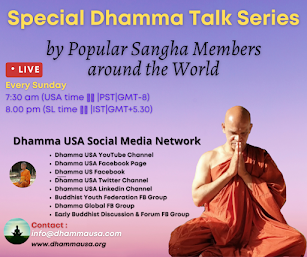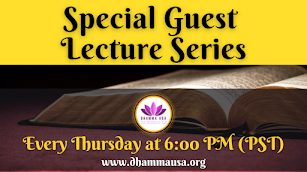**Understanding Mental Corruptions in Meditation – A Path to True Peace**
Upakkilesa Sutta (MN128)
On this sacred Vesak Day, we come together to reflect on the profound teachings of the Buddha, celebrating his birth, enlightenment, and passing away. As we commemorate this special day, let us delve into an insightful teaching from the *Middle Discourses* (MN 128), which explores the subtle mental corruptions that can hinder our progress in meditation—especially when we are on the verge of achieving deep absorption and enlightenment.
### The Buddha's Insight into Mental Corruptions
Even the most focused and diligent meditation practice can be disrupted by subtle disturbances, which the Buddha referred to as "corruptions." These mental distractions arise when the mind is nearly absorbed in meditation but still vulnerable to certain disturbances. Understanding these corruptions and how to overcome them is essential to moving forward on the path of peace and liberation.
### The Situation at Kosambī: A Lesson in Harmony
The Buddha was once staying near Kosambī, where the mendicants were constantly quarreling and disputing. Despite the Buddha’s repeated requests for them to stop, they continued to argue, caught in the grips of anger and frustration. In this story, the Buddha highlights the importance of **harmony** and **unity**—even among those who are practicing the Dhamma.
Just as the mendicants at Kosambī were caught in conflict, we too may encounter internal disputes—whether with others or within ourselves—that disturb our peace. These conflicts, whether external or internal, prevent us from achieving the clarity and concentration needed for meditation.
### The Mental Corruptions: Subtle Hindrances in Meditation
The Buddha identified several subtle corruptions that can arise during meditation, which prevent us from entering deeper states of concentration (jhana) and insight. Let’s take a closer look at these mental hindrances:
#### 1. **Doubt**
**What it is:**
Doubt arises when we question the effectiveness of our practice or our ability to achieve the desired results. We may wonder if we are following the right methods or if meditation will really lead to enlightenment.
**How it disrupts meditation:**
Doubt shakes the foundation of our practice, leading us to focus on questions and uncertainties instead of the meditation object. For example, instead of focusing on the breath, we may become preoccupied with thoughts like, "Am I doing this right?" or "Will this really work?" Such distractions prevent the mind from settling into calm and deep concentration.
**How to overcome it:**
The antidote to doubt is **confidence**. We must cultivate trust in our practice and our ability to progress. By reflecting on the purpose of our practice, recalling the experiences of other meditators, and relying on the guidance of our teachers, we can strengthen our confidence and overcome doubt.
#### 2. **Loss of Focus**
**What it is:**
Loss of focus occurs when the mind begins to wander away from the meditation object. We might start thinking about unrelated things—our daily responsibilities, past events, or future concerns.
**How it disrupts meditation:**
When the mind loses focus, we move away from the meditative state of awareness and clarity. Instead of fully engaging with the breath or the present moment, we become caught up in thoughts, preventing the mind from entering deep concentration.
**How to overcome it:**
To overcome loss of focus, we gently bring the mind back to the meditation object each time we notice it has wandered. **Mindfulness** helps us observe when the mind drifts and refocuses attention without self-judgment or frustration.
#### 3. **Dullness and Drowsiness**
**What it is:**
Dullness refers to a lack of energy or alertness, while drowsiness involves feeling sleepy or lethargic.
**How it disrupts meditation:**
When the mind is dull or sleepy, concentration weakens. We may lose clarity of thought or even fall asleep, making it difficult to reach the depth needed for insight or absorption.
**How to overcome it:**
To overcome dullness and drowsiness, we can bring energy and alertness into our practice. Adjusting posture, taking deep breaths, or focusing on the body’s sensations can invigorate the mind and keep it alert.
#### 4. **Terror and Fear**
**What it is:**
Terror or fear can arise due to external circumstances or internal anxieties, such as confronting past trauma or unresolved emotions.
**How it disrupts meditation:**
Fear is a strong emotion that can destabilize the mind, causing it to break concentration. We might resist meditation or attempt to escape from the feelings of fear, which further disturbs our practice.
**How to overcome it:**
We approach fear with **mindfulness** and **equanimity**. Rather than avoiding it, we observe fear without judgment, allowing it to fade naturally. **Loving-kindness meditation** can also help calm anxiety and reduce fear by cultivating compassion for ourselves and others.
#### 5. **Elation and Over-Excitement**
**What it is:**
Elation arises when we become overly excited about the progress we’re making in meditation, especially after experiencing deep concentration or insight.
**How it disrupts meditation:**
When we become too excited, the mind loses stability and focus. This excitement disturbs the calm, making it difficult to maintain balance and prevent further distractions.
**How to overcome it:**
To overcome elation, we need to practice **patience** and **humility**. We should remember that meditation is about letting go of expectations and being content with whatever arises in the present moment.
#### 6. **Discomfort**
**What it is:**
Discomfort can arise from physical sensations, such as pain or stiffness, particularly during long sittings.
**How it disrupts meditation:**
When discomfort takes over, it can draw attention away from the meditation object. The mind may start resisting the pain, which creates agitation or frustration.
**How to overcome it:**
To overcome discomfort, practice **mindfulness of the body**. Acknowledge the discomfort without reacting to it. Adjust your posture or simply observe the sensations with curiosity, not trying to change them but allowing them to pass naturally.
#### 7. **Excessive Energy or Laxity**
**What it is:**
Excessive energy happens when we push ourselves too hard, causing tension and restlessness. Laxity arises when there is not enough effort, and the practice becomes lazy or disengaged.
**How it disrupts meditation:**
Both excessive energy and laxity prevent the mind from entering deep concentration. If we exert too much effort, the mind becomes tense. If we exert too little effort, we become disengaged.
**How to overcome it:**
The key is to find a **balanced effort**. If you feel too tense, relax the body and mind. If you feel lazy or uninterested, apply more effort to bring your attention back to the meditation object.
### Overcoming the Corruptions: The Path to True Peace
The Buddha showed us that overcoming these corruptions is essential for deepening our meditation practice. When we acknowledge and let go of these mental hindrances, the mind becomes peaceful and focused. This focus leads to insight, which brings true liberation.
The Buddha’s realization is profound: **“When I had developed immersion in these ways, the knowledge and vision arose in me: ‘My freedom is unshakable; this is my last rebirth; now there’ll be no more future lives.’”**
This is the ultimate goal of meditation—a peace that transcends all disturbances and a freedom that is unshakable.
### Conclusion: Cultivating Peace and Wisdom
As we celebrate Vesak today, let us reflect on the Buddha’s teachings about overcoming the subtle corruptions that arise in meditation. With patience, mindfulness, and diligence, we can continue our journey toward true peace, wisdom, and liberation.
May we all overcome these mental hindrances and achieve the deep meditation that leads to liberation, as we follow the Buddha’s path with diligence and compassion.
**Sadhu, Sadhu, Sadhu.**
---































